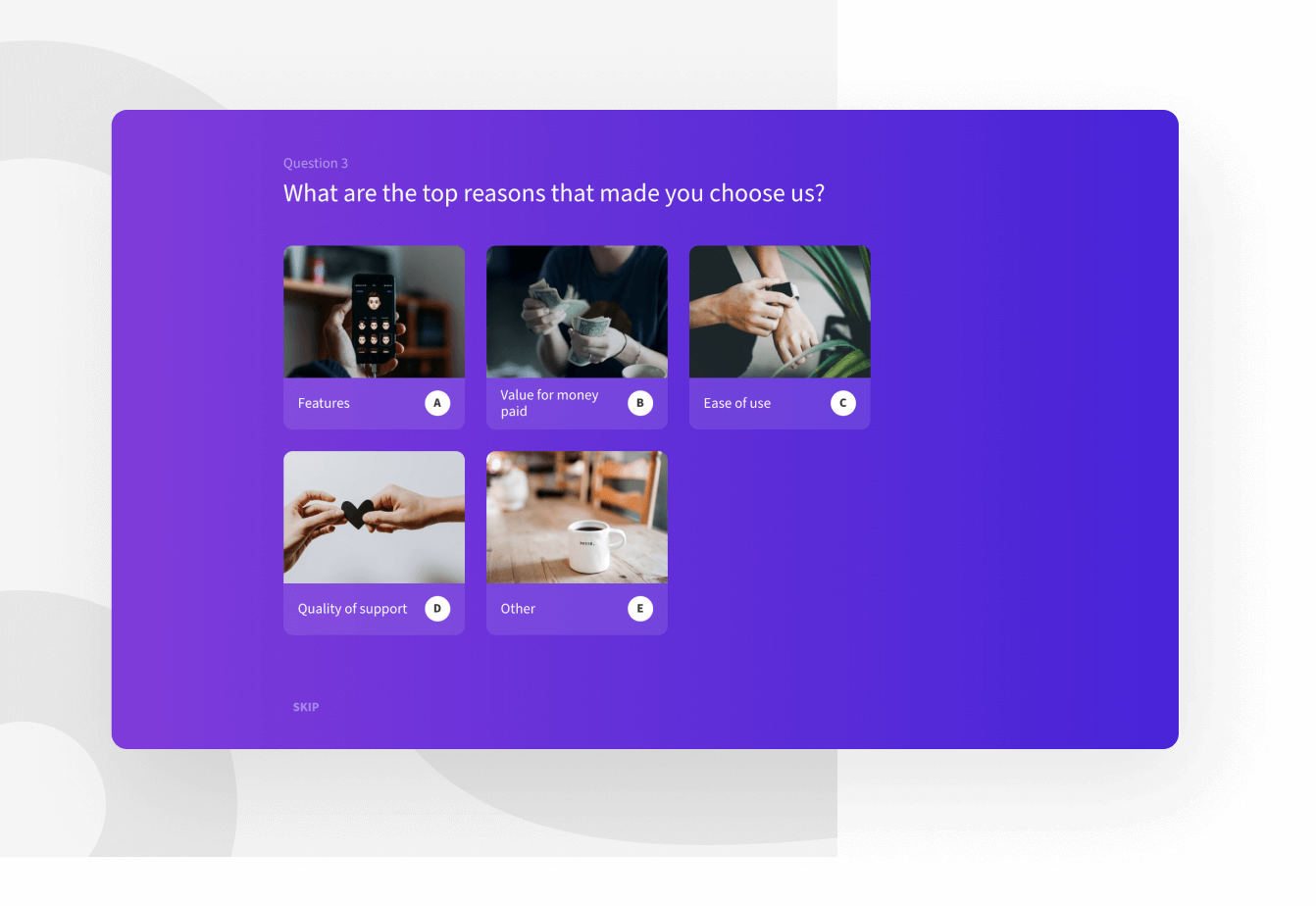What Are The Different Types of Surveys? - All About Surveys

Kate Williams
Last Updated: 6 June 2024
16 min read

“I can’t believe it. Over 10,000 folks signed up to our website in just 2 days. All because of that campaign. Just letting you guys know that we’ve hit a home run here!”
Before you think, what on earth is this? It’s Doug, our client’s CMO. He’s just ecstatic about the market research survey they conducted to test their upcoming product. They conducted it around a month back while the product was launched just a few days ago. And you can read from his reaction how well it’s performing.
Well, Doug certainly thinks this happened because of the changes they made based on the survey feedback. We’re 100% agreeing to that. Surveys of any type, shape, and form have always brought the right results when designed in the right manner. Doug and his company’s recent success is another example of that.
We want the same success for you. That’s why we want to address all that you need to know about surveys. The reasons to use them, types of surveys, the designing process, we’ve covered everything here. We promise that all that you would be left to do is start using them by the end. So, with no further wait, let’s start and delve deep into the world of surveys.
10 Questions That Highlight The Need To Conduct Surveys
Before jumping to discuss anything else in this blog, it’s important to talk about the need for surveys in your business.
What good would it do?
How would it help in bringing sustained growth?
That’s what we want to answer. But our primary goal is to help you develop the right survey campaigns to achieve set goals. For that, let’s address the different questions that, as a leader, you must’ve asked yourself countless times. Why questions? Because these in themselves are the reasons to use surveys actively.
#1 How Can I Know The Customers Better?
If this question is constantly going in your head, you need to conduct customer surveys. This is because your products/services should fulfil the needs and requirements of your customers. Only then will they truly succeed. So, starting with surveys, preferably online, to get their basic information and then stepping it up to know their likes and dislikes is what you should do. 
#2 Are The Customers Satisfied With The Products & Services?
This is a question that comes when someone is already your customer. You now want to know how satisfied they are with your products, service, and ultimately your brand. Out of the many types of surveys available, conducting Customer Satisfaction Surveys (CSAT) is the easiest way to figure out.
#3 Are The Customers’ Promoters Of Your Brand?
This is the question that brings Net Promoter Score surveys into the picture. It’s one of those types of surveys that help you figure out whether the customers are promoters, neutrals, or detractors for your brand, by asking them to answer relevant questions on a scale from 1 to 10.
Here’s a glimpse of an NPS Survey Created using SurveySparrow:
NPS Survey Template
Use This TemplateYou too can create such simple, yet engaging surveys and yield better response rates. Signup for Free here:
14-day free trial • Cancel Anytime • No Credit Card Required • No Strings Attached
#4 What Do The Customers Like And What Do They Don’t?
If personalization is your goal, this question is there in your mind. And among all the different types of surveys, a customer feedback survey is an answer to this. Why? It lets you collect relevant data about them that allows your team to wow them with personalized products, services, and discounts. Believe us. The customers would love their association with your brand after such personalizations. It’s just so damn powerful!
#5 How Can We Build Better Products? How Would Future Products Perform?
Achieving breakthrough and success once is easier than repeating that again and again over time. If you want the business to keep growing, you and your employees need to keep building better products. You can’t just bask in the glory of one successful product. Evolving continuously is how you keep growing, and surveys are a sure-fire way to do that. How? Because it lets you know how your customers are changing. What new are they liking? And what old are they leaving? Based on this feedback, your product team can upgrade existing products or work towards shaping new ones that can replicate or even better the past successes.
#6 Are There Any Reasons For The Customers To Leave?
See, no matter how good your products or services are, some customers would leave. It doesn’t mean it was because of you or your team. But what’s the harm in conducting customer exit surveys to find the reason? You want to improve and keep such exits to a minimum, right? The responses from the feedback surveys would help you do exactly that, as everyone would learn and improve from their mistakes to not let the same happen in the future.
#7 How Well Is The Customer Service Team Doing?
This becomes an important question to answer since your customer service team’s performance would influence customer satisfaction massively. This is where Internal Quality Survey (IQS) comes in. As the name suggests, it’s a metric based on an internal evaluation given by peers, managers, and leaders to every customer representative. IQS allows you to maintain the right quality standards while working to improve customer satisfaction.
#8 How Satisfied Are The Employees? Are They Growing Along With The Company?
Employee satisfaction has garnered a lot of attention in the pandemic’s wake. And we also think it’s right to focus on their satisfaction levels and ask yourself this question. A 360 degree feedback software is what you need to answer this. Happy employees mean happy customers. Always remember that.
#9 How Efficient Are The Internal Processes Of The Company?
From the various types of surveys to choose from, you need process evaluation surveys to answer this question. Because customers can’t be given the right service and attention if the internal processes are not right. So, to check what’s going right and what’s not behind the doors, you need a process evaluation survey. That’ll help you find how well the initiatives have been implemented, and in what ways can they be further improved?
#10 Are We Pricing The Products Right?
If you look around in any market, you’ll notice that competing companies are pricing their products and services within a similar pricing range. And more often than not, this is because no one has it figured out, and they’re just copying each other. If you don’t want to get into this, a price sensitivity survey is what you need.
A price sensitivity survey is one of those types of surveys that would help you figure out the market’s attitude around pricing and how well are the customers taking to it. And apart from this 1 question, you’ll also get answers to;
Is there room for a premium solution?
Are people only willing to pay bargain prices?
Will the prices support the ongoing expenses while yielding a profit?
Different Types Of Survey Techniques
The bottom line from the previous section, if sustained growth is the aim, surveys can’t be ignored! But if you want to start with a survey campaign to collect actionable data on your products, customers, or even your employees, knowing about the different survey-taking techniques becomes important. Knowing about these techniques would help you figure out the right one for your survey needs. And that’ll help you achieve all your set goals. Ok, enough of this introduction here; let’s jump right in and start.
Online Surveys
This is one of those types of surveys that came with the age of technology. And with the technology advancing with each passing day, online surveys are getting better and better. This survey technique requires an online survey software that sends the selected questions to the customers, employees, or target audience to get their feedback. The best part about using online surveys is that they can be accessed from anywhere and at any time by your respondents. Plus, they are super easy to design too. Frame the relevant questions, select or create a suitable template, white label it according to your brand, select a channel to send, and just press the send button.
Now, online surveys again have 6 major categories based on the purpose they are created for.
Net Promoter Score (NPS) Surveys
This online survey type helps you understand and determine the likelihood of your product/service being recommended by an existing customer. It shows your customer’s loyalty and brand advocacy.
Customer Satisfaction Surveys (CSAT)
As the name suggests, CSAT surveys help you measure the level of satisfaction customers have with your products and services.
Market Research Surveys
It’s one of those unique types of surveys carried out before the launch of a product/service. It helps you and your team understand the market trends and analyze the viability of a product/service that would be launched.
Post-Event Surveys
It is used by companies and event organizers to measure how successful the recent event or conference was based on the attendee feedback.
Employee Satisfaction Surveys
It’s one of the most crucial types of surveys that helps you and your HR team to engage better with employees and measure their satisfaction levels to keep them satisfied & happy.
Academic Research Surveys
Employed by high school and grad students to support and validate their research with fresh, real-world, primary data.
Paper Surveys
This is one of those types of surveys that was massively used before online surveys. With paper surveys, a traditional pen and paper approach was used to collect feedback from the target group. It was then collected and analyzed to find relevant patterns to help a business grow further. Because of its sheer volume, paper surveys were an expensive technique, but it could go anywhere, as it was only a piece of paper! Even now, in places where computers and technology can’t go, paper surveys are used. And they get the job done.
Telephonic Surveys
Telephonic surveys are used by researchers to conduct research and interview people over telephones. Respondents need to answer questions asked by them, and based on the responses, and researchers conclude their research topic. To be honest, these types of surveys are really time-consuming and sometimes even non-conclusive. Because the success here depends on the number of people who want to invest their time in answering questions. And many a time, this number is not enough.
One-to-one Interviews
For collecting feedback and answers on a research topic, one-to-one interviews are a better option. It is a time-consuming process, no doubt. But a researcher would get the unwavering attention of the respondent, which will allow them to get more thoughtful responses. So, if the quality of responses is the key, one-to-one interviews are what you should go for.
Kiosk Surveys
Kiosk surveys are one of those modern types of surveys that has a very interesting way to collect respondent feedbacks. It uses a computer screen at a physical kiosk where customers are requested to take a feedback survey right after a purchase or hotel stay. The response they give is more authentic because their experience is fresh. You must’ve seen these kiosks inside the shopping malls and in hotel lobbies. And trust us, they’re collecting some very rich and fresh data from these kiosks!
The Survey Design Process. Where To Start & How To End?
Till now, we’ve talked about how surveys will help your business and what are the different types of surveys that can be used. But how do you design a survey? What are the processes involved in designing a survey that can engage the respondents until the very end? We’re pretty sure you have these 2 questions in mind, which is exactly why we’ll talk about them here. So, without keeping you waiting anymore, let’s start.
Set The Right Goals
Before even thinking about your target audience, the tool you would use, or the questions you would include, it’s crucial to first decide the goals you want to achieve by conducting surveys. Because let’s face it, without the right goals, conducting surveys would be like playing a football match without knowing what to do. That would reap no rewards other than just tiring you up completely.
So, when you have a clear sight of goals, the entire process of designing and conducting a survey makes total sense. That’s why this has got to be the first step for your survey designing process.
The Target Group
“Success of our new line of accessories.”
Let’s say this is the goal you and your team have kept for the survey campaign. Then, who would be the target group for it? This is the question that comes next in the survey designing process. For this group, the females and males aged between 17-50 would be the right audience. But this too depends on the price range of your products, among other factors, because if the prices are on the higher side, it won’t be affordable for most grad school students. So, after considering all the aspects of your goal, the final target group gets formed. See, you cannot target anyone, and even if you can, why would you want to do that? Surveying the right audience would give you the right data to decide, but surveying anyone and everyone would give only irrelevant data.
The Size Of The Group
Once the target group is decided, it’s time to put a number on it. By number, we mean the size of the target group for your surveys. The target group should be large enough to collect conclusive data and small enough to process the collected data properly. One of the contributing factors to this would be the total size of the target group. If you’ve narrowed it down to a good level, you can even choose to survey the entire group.
Type Of Survey
Now that you know the goal, the target group, and its size, it’s time to select from the various types of surveys that you can deploy. It could be online, paper, telephonic, or any other. What matters the most is that it should reach your target audience. So, go where your customers are. You’ll get the results you’re looking for!
Selecting The Right Survey Software
If you’re going with traditional surveys like paper and telephone, you don’t need to worry about choosing any tool. But if you want to conduct online surveys, selecting the right online survey software becomes really important.
Enter SurveySparrow. This omnichannel survey software has got everything you need from an online survey software. Let us quickly list down some of its features that make it the perfect survey tool for you:
#1 Omni-channel Response Collection
One of the most used and applauded features of SurveySparrow is its omnichannel experience management platform. Businesses get to collect data by sending surveys on multiple channels, be it social media or emails.
#2 White labelling
The white-labelling feature lets your team customize everything from the URL to the brand logo, subject, and body of the surveys to bring out the brand identity.
#3 Built-in NPS module
With its built-in Net Promoter Score (NPS) module, you get to view who are the Promoters, Passives, and Detractors of your brand. And you can take action to bring changes based on this.
#4 Offline data collection
SurveySparrow’s offline data collection feature allows your team to collect data offline from anywhere and anytime. Using SurveySparrow’s inbuilt survey app, you can add as many offline devices as you want and conduct as many surveys as you need to.
#5 360 degree employee assessment
With this feature, you get to upload all the employee information in one go, invite them for employee 360 feedback & assessment with a single click, understand their strengths and weaknesses, and get custom reports with a dedicated development plan for each employee.
The Questions
The last and the most important part of the survey design process is to decide and include questions that can keep the respondents engaged until the very end. Because if a respondent doesn’t like a question, they’ll not answer it. And this won’t get you the feedback you’re looking for. So, use these 6 tips to frame top-notch questions for your survey:
- Keep the questions short. Single line questions line would be ideal.
- Use extremely simple words. Don’t make your questions sound complicated.
- Avoid question fatigue. Try not to use only one type of question in the survey. Mix it up with open-ended, close-ended, or rating-type questions.
- Every question in the survey should come in a logical flow.
- Refrain from asking any negative question. For example: How bad do you think yesterday’s seminar was?
- Stay honest. Don’t add unnecessary questions to get more data.
Wrapping Up…
There you have it. We’ve discussed everything from stating the reasons to conduct surveys to talking about the complete survey design process. In between, we also talked about the different types of surveys that you can choose from. So, what we had set out to achieve with this blog is completed. Now it’s your turn! Yes, it’s your turn to take out all the value nuggets from this and start putting them into use by conducting valuable surveys. We hope you start soon. Happy surveying!

Kate Williams
Product Marketing Manager at SurveySparrow
Excels in empowering visionary companies through storytelling and strategic go-to-market planning. With extensive experience in product marketing and customer experience management, she is an accomplished author, podcast host, and mentor, sharing her expertise across diverse platforms and audiences.
You Might Also Like

Turn every feedback into a growth opportunity
14-day free trial • Cancel Anytime • No Credit Card Required • Need a Demo?




